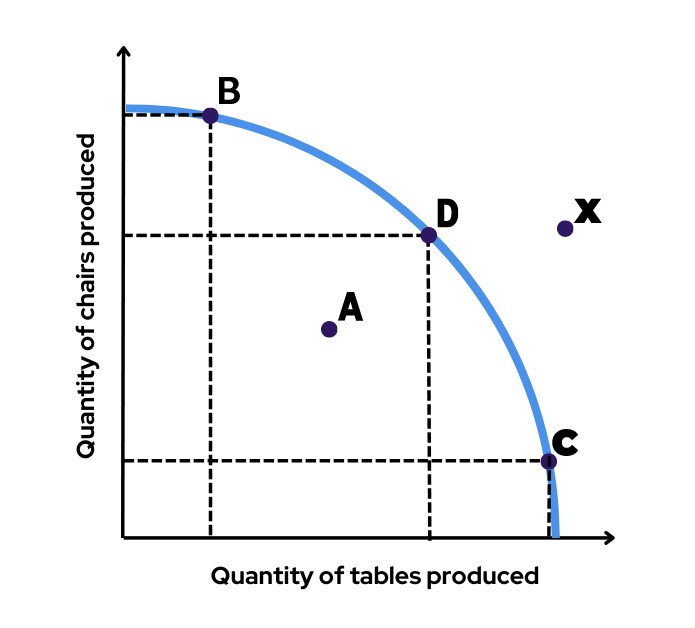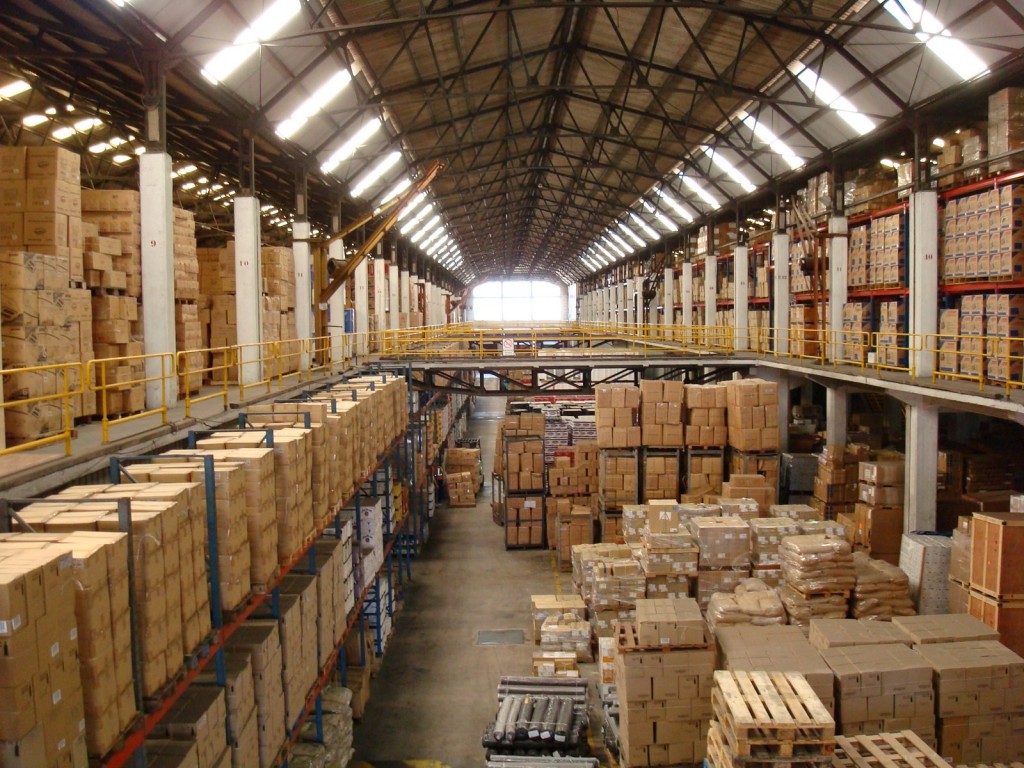How to Measure and Increase Production Efficiency?
Production efficiency indicates how much a production unit manufactures with the given amount of resources. Measuring and tracking production efficiency enables manufacturers to identify bottlenecks, optimize processes, and improve their overall productivity and profitability.

What is production efficiency?
Production efficiency essentially shows how much an economy, an operation, or a piece of equipment manufactures with the given resources. Measuring and improving production efficiency is a critical aspect of good microeconomics that focuses on achieving the maximum output level with the resources available.
Achieving high levels of production efficiency involves optimizing the production process to minimize waste, reduce costs, and maximize output without compromising quality. Efficient production can be attained by implementing various steps and methodologies, including standardization, effective maintenance, demand forecasting, continuous improvement, etc.
Allocative efficiency vs. productive efficiency
Allocative efficiency is about producing the right mix of goods that aligns with customer preferences and demands. It means hitting the sweet spot where the marginal cost of making one more unit of a product is just right for the price customers are willing to pay for it. When we reach this point, this output mix, we know we are not wasting resources on products that are not valued by the market. If we make less, there will be a sales opportunity loss. If we make more, we must sell at a discount.
Productive efficiency, on the other hand, is about ensuring that the manufacturing process operates at its maximum production capacity and achieves the highest output level attainable with the given resources. This ensures that goods are produced at the lowest possible cost. In manufacturing, achieving productive efficiency involves eliminating inefficiencies, optimizing workflows, and reducing waste.
While the two concepts are different, they are also interconnected, with productive efficiency providing the basis for allocative efficiency.
What is the Production Possibility Frontier (PPF)?
An important part of the concept of production efficiency, the production possibility frontier (PPF), also known as the production possibility curve or boundary, is a graphical representation that illustrates the maximum output combinations of two goods or services that an economy can produce given its available resources and technology. It showcases the trade-offs that exist between different production choices.
The PPF is typically depicted as a curve on a graph, with one product represented on the x-axis and the other on the y-axis. The curve shows the various production combinations that can be achieved, given the available resources and technology, while maintaining full capacity and utilizing all available resources. The curve is usually downward sloping, indicating an increasing opportunity cost that comes along with the production of another product.
Points on the PPF line represent an efficient use of resources, where it is not possible to produce more of one good without giving up some quantity of the other. A point inside the curve represents the underutilization of resources, while a point outside the curve represents an unattainable level of production given the available resources and technology.

How to measure production efficiency?
Measuring production efficiency is crucial to assess the performance of a manufacturing company. By utilizing appropriate metrics and KPIs, businesses can identify and eliminate bottlenecks, optimize processes, and improve overall productivity and profitability. Here are some key methods to measure production efficiency, along with the most important production efficiency formulas:
Overall Equipment Efficiency (OEE)
Overall Equipment Effectiveness (OEE) is a comprehensive metric that considers availability, performance, and quality to assess the effectiveness of equipment utilization. It quantifies the actual output rate relative to the standard output rate, helping identify areas of improvement, such as downtime reduction and cycle time optimization.
OEE = Availability × Performance × Quality
Example
Assume we have a production line that operates for 8 hours a day (480 minutes). The planned production time for the day is 400 minutes, considering that scheduled breaks and changeovers take 80 minutes in total. The ideal cycle time for processing one unit is 5 minutes. During the 400 available minutes, the line experiences a total of 30 minutes of downtime, making the real run time 370 minutes. During this time, the line produces 60 units, out of which 55 are considered good units that meet quality standards.
Now, let’s calculate the OEE using the formula:
OEE = Availability × Performance × Quality
Availability: (Real Run Time / Planned Time) × 100%
Performance: (Total Units x Ideal Cycle Time) / Real Run Time
Quality: (Number of Good Units Produced / Total Number of Units Produced) × 100%
Availability = (370 minutes / 400 minutes) × 100% = 92.5%
Performance = (60 units x 5 minutes) / 370 minutes x 100% = 81.1%
Quality = (55 units / 60 units) × 100% = 91.7%
Now, let’s calculate the OEE:
OEE = 92.5% x 81.1% x 91.7% = 69%
Therefore, the OEE for the production line in this example is 69%.
Cycle time
Cycle time measures the time taken to complete one cycle of a production process, from start to finish. It indicates the efficiency of the manufacturing process, allowing for the identification of bottlenecks and areas where productivity could be enhanced.
Cycle Time = Real Run Time / Number of Units Produced
Example
Using the data from the OEE example, we assume that the real run time of the machine is 370 minutes and the number of units produced is 60.
Cycle Time = 370 / 60 = 6.2 minutes
Yield
Yield measures the number of high-quality units from the total number of units produced. It helps identify areas of waste, such as scrap or rework, and highlights opportunities to improve quality control measures.
Yield = (Number of Good Units Produced / Total Number of Units Produced) × 100%
According to the example above, the production line produces a total of 60 units, 55 of which are up to quality standards. Yield is, therefore:
Yield = 55 / 60 x 100% = 91.7%
As you can see, the yield is the same as the Quality variable in calculating OEE.
Unit cost
Unit cost is a fundamental metric that calculates the average total cost per unit produced. Monitoring unit cost provides insights into how resources are allocated period by period, helps identify cost-saving measures, and enables you to adjust the company’s pricing policies.
Unit Cost = Total Manufacturing Cost / Number of Units Produced
Total Manufacturing Cost is a manufacturing accounting metric that is comprised of three elements: direct material cost, direct labor cost, and manufacturing overhead.
Example
Assume that a manufacturing operation incurs a total of $10,000 in costs to produce 1000 units of a product.
Unit Cost = $10,000 / 1000 = $10
Read also about the Top 10 Manufacturing KPIs.
Production efficiency challenges faced by SMEs
Small and medium-sized manufacturers experience a unique set of challenges in relation to production efficiency that can significantly impact their ability to compete in the market. Here are some common obstacles faced by small manufacturers when it comes to their production efficiency:
Limited resources
Small manufacturers typically operate with constrained resources, including manpower, machinery, and capital. This limitation can hinder their ability to invest in advanced technology, upgrade equipment, or hire specialized staff to optimize production processes. The lack of resources often leads to inefficiencies and prevents small manufacturers from reaching their full production potential.
Lack of scalability
Small manufacturers often struggle with scalability, particularly during periods of sudden growth or increased demand. The production infrastructure that may have been sufficient initially might not be able to handle higher volumes efficiently. Scaling up operations while maintaining or improving efficiency can be a daunting task, requiring careful planning, investment, and process optimization.
Diverse roles and responsibilities
In small manufacturing businesses, employees often wear multiple hats, performing various roles and responsibilities. While this can promote flexibility, it also means that individuals may not have the specialized knowledge or skills to address specific production efficiency challenges. This lack of expertise can result in suboptimal processes and hinder efforts to improve efficiency.
Supply chain constraints
Small manufacturers often face challenges in managing their supply chains effectively. Limited bargaining power with suppliers, inconsistent material availability, and delays in receiving raw materials can disrupt production schedules and affect efficiency. Coordination and collaboration with suppliers become crucial for small manufacturers to ensure a smooth flow of materials and avoid production bottlenecks.
Limited access to technology and automation
Small manufacturers may face difficulties in adopting advanced technology and automation due to cost constraints. Many automated production systems, robotics, and data analytics tools that enhance efficiency may be financially out of reach for many small businesses. This lack of access to technology can make it challenging to gather meaningful data for performance analysis and improvement. There are, however, some affordable cloud-based solutions available for small and medium-sized manufacturers that enable them to optimize their operations.
Practical steps to raising your production efficiency
Although manufacturing SMEs face many challenges when trying to increase their production efficiency, Boosting production efficiency requires a comprehensive approach that encompasses various aspects of the manufacturing process. Here are some efficiency measures that you can take in your manufacturing business:
- Standardize and streamline. Create SOPs for your manufacturing processes to introduce consistency into your workflows, a prerequisite for efficiency tracking and bottleneck detection.
- Implement preventive maintenance. Set maintenance intervals for your machinery according to pieces processed or hours worked.
- Keep your supply chain well-oiled. Properly planning your purchases and fostering strong relationships with suppliers enables you to prevent stoppages due to stockouts and keep the machines running.
- Empower employees. Bestowing responsibility for their stations to your employees, asking for their input, incentivizing innovation, and regularly providing training will help you mobilize workers to optimize processes.
- Ensure allocative efficiency. It is not all about trying to use the full capacity of your equipment. You also have to make sure that you are using that capacity to produce the right mix of products for the right market. Use procedures such as SKU rationalization to trim the excess from your product catalog.
- Optimize production planning and scheduling. Utilize accurate demand forecasting to align production levels with market demand and make sure your production schedules and work orders match your available manufacturing resources.
- Track key performance indicators for continuous improvement. Consistently monitor and analyze KPIs relevant to production efficiency. Regularly review and evaluate data to identify trends, areas for improvement, and potential bottlenecks.
- Implement a manufacturing ERP system. All of the challenges above can be overcome and the steps to greater efficiency can be much more easily achieved by implementing a manufacturing ERP system. Manufacturing ERP or MRP software is used to integrate various parts of a manufacturing company, ensuring efficient data analysis and communication. An MRP/ERP system prompts you to standardize your operation and allows you to effortlessly calculate material requirements and plan purchases, create effective production and maintenance schedules, provide employees with easy access to data pertaining to their jobs, use historical data to create accurate demand forecasts and analyze the sales performance of your products, and monitor various KPIs vital to your operation.
By properly implementing these steps, you can achieve continuous improvement and gain an important advantage over your competitors.
Key takeaways
- Production efficiency is the output of a manufacturing unit with the given resources. Increasing it involves maximizing output with the allocated resources and is crucial for optimal resource utilization.
- Allocative efficiency focuses on producing the right mix of goods based on customer preferences, while productive efficiency aims to achieve maximum output with minimum resource usage.
- The production possibility frontier (PPF) illustrates the maximum output combinations that an economy can produce given its resources and technology, showcasing trade-offs between different production choices.
- Measuring production efficiency involves metrics like OEE, cycle time, yield, and unit cost, which provide insights into equipment utilization, process efficiency, quality, and cost-effectiveness.
- Small manufacturers face challenges such as limited resources, scalability issues, diverse roles, supply chain constraints, and limited access to technology.
- Practical steps to improve efficiency include standardization, preventive maintenance, supply chain management, empowering employees, ensuring allocative efficiency, optimizing planning and scheduling, tracking KPIs, and implementing a manufacturing ERP system.
Frequently asked questions
Production efficiency generally means maximizing output while minimizing resource usage in a manufacturing process.
An example of production efficiency is a wooden table manufacturer that consistently produces a high volume of quality tables while minimizing material waste, optimizing production processes, and ensuring on-time deliveries to meet customer demand efficiently.
Good production efficiency is achieved when a manufacturing process operates at its maximum capacity, minimizing waste and utilizing resources effectively to achieve high output levels.
The production efficiency formula varies depending on the specific metric being measured, such as OEE (Overall Equipment Efficiency), which is calculated as Availability x Performance x Quality.
You may also like: Production Routing – Definitions, Tips, and Examples




